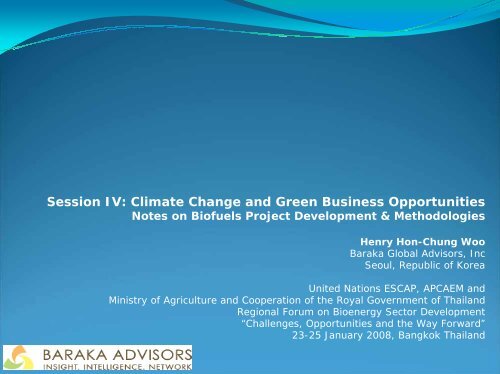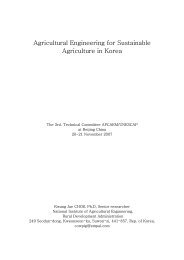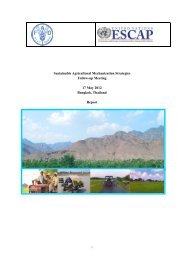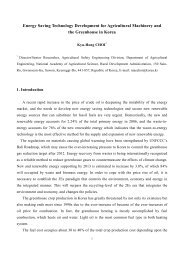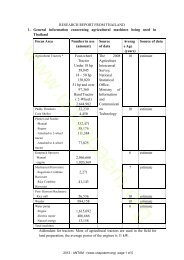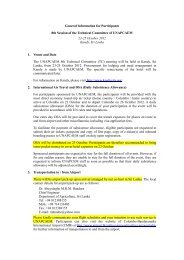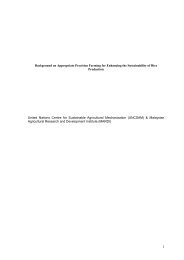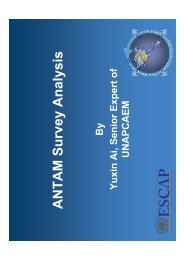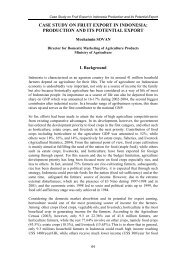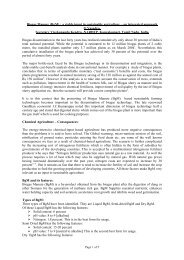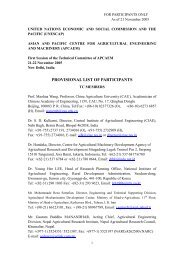Notes on Biofuels Project Development & Methodologies
Notes on Biofuels Project Development & Methodologies
Notes on Biofuels Project Development & Methodologies
- No tags were found...
Create successful ePaper yourself
Turn your PDF publications into a flip-book with our unique Google optimized e-Paper software.
• Envir<strong>on</strong>mental C<strong>on</strong>cerns in Biofuel1. Land Use Competiti<strong>on</strong> (Sumatra Example)• Loss of habitats• Endangering or extincti<strong>on</strong> of rare species• Obstructi<strong>on</strong> of migrati<strong>on</strong> patterns and corridors• Degradati<strong>on</strong> of soils and water bodies2. Food crops V.S. <strong>Biofuels</strong>• Alleviate poverty• Food Security (Malaysia example)3. Loss of Biodiversity• Preferring crop varieties and farming schemes• Ecological stepping-st<strong>on</strong>es
• Social Impacts and Human Health• Restricti<strong>on</strong>s <strong>on</strong> access to land for small-scale farming• Labor c<strong>on</strong>diti<strong>on</strong>s – Labor laws & protecti<strong>on</strong>• Human health – Agricultural methods• Air pollutants – Biofuel making is an Industrial process• ChallengesChallenges from future biofuel developments in developing countries• Diversi<strong>on</strong> of land from into energy crops• Changes of supply and prices of food (ec<strong>on</strong>omics of food)• Access to relevant energy technology
• <strong>Project</strong> <strong>Development</strong> Level (PM-EPC)-Life cycle Analysis of BiofuelThree key input parameters –• allocati<strong>on</strong> method for co-product/transport (Net Emissi<strong>on</strong> Reducti<strong>on</strong>s)• N2O emissi<strong>on</strong>s which evolve from nitrogen fertilizer applicati<strong>on</strong>and leaf litter decompositi<strong>on</strong>• soil carb<strong>on</strong> dynamics (biomass farming)• Maximizing GHG savings with biofuels benefits• GHG reducti<strong>on</strong>s (20% - 90%)• More efficient land use
How does Biofuel CDM works?•Applicable Methodology :AR-AMS 1 / AR-AMS 4• Applicable Methodology : ?• Expected CERs amount : estimatedto be around 140,000 - 180,000CERs/ year•Applicable Methodology :ACM006/ AM0036• Expected CERs amount : 30,000CERs/year
• <strong>Biofuels</strong> at the CDM Level<strong>Biofuels</strong> CDM project:Emissi<strong>on</strong> Reducti<strong>on</strong> = Baseline – <strong>Project</strong> Activity - Leakage<strong>Biofuels</strong> CDM project - AmbiguityStage I – Farming Period (Fertilizer, carb<strong>on</strong> absorpti<strong>on</strong>, etc)Stage II – Biofuel Producti<strong>on</strong>Stage III – Sales and Marketing of Biofuel• Producti<strong>on</strong> CDM V.S. Fuel Switch CDM• <strong>Project</strong> Developers V.S. Owners (Ownership of Carb<strong>on</strong> Credits)Stage I Stage II Stage IIISoil Carb<strong>on</strong> Absorpti<strong>on</strong>,Fertilizer, n2o, etc.Industrial Emissi<strong>on</strong>s,Fossil fuels & ElectricityAccountability, BlendingPower/Ind./c<strong>on</strong>sumer
• Suitability analysis of biofuel projects under theCDM1. Assessment criteria• Significant greenhouse gas reducti<strong>on</strong>?• Additi<strong>on</strong>ality – Would the project be viable w/out CDM?• M<strong>on</strong>itor-ability, Baseline & <strong>Project</strong> Activity, End-Users• Sustainable development c<strong>on</strong>tributi<strong>on</strong>- Energy security of supply-Employment- Natural envir<strong>on</strong>mentOverall viability- Achieve a minimum internal rate of return- Help in l<strong>on</strong>g-term sustainability of the project
• Suitability analysis of biofuel projects under theCDM - II2. General Barriers (things you should tell your CDM projectdevelopers)• Regulatory barriers – What are the domestic law?• Technological barriers• Market potential• Biomass supply – Quantity, proximity (PROJECT ACTIVITY)
A: Means approved by the ExecutiveBoardB: Means that the projectparticipants/EB must make somechangesC: Means that a new <strong>Project</strong> DesignDocument must be submittedWIP: Work In ProgressSource: UNEP-Risoe
Comparative corps yields (UK)Bio-efficiency50454035302520151050% of arable land needed to supply 5% of energy fortransportWheat Straw ethanolRapeseed biodieselCereal ethanolWood biodieselSugar beet ethanolSource: Royal Society
C<strong>on</strong>clusi<strong>on</strong>• Oil prices, alternative energy needs• PE, FIs & MNCs• Industrial activities & employment• Income of agricultural communities• Social and envir<strong>on</strong>mental c<strong>on</strong>cerns• 2 nd Generati<strong>on</strong> technology is needed• CDM risks – <strong>Methodologies</strong> <strong>Development</strong> (Hard to generalize, unify)• UNFCCC Politics (Brazil, Ind<strong>on</strong>esia, US, China, etc)• Careful Kyoto policies developing m<strong>on</strong>itoring & applicati<strong>on</strong>• Challenge = Opportunity (CERs is substantial)• CDM - to support “worthwhile” projects
Thank you!henry.woo@barakaadvisors.comOffice: 02 2051-3091Time Co. B/D, 5FL, 827-59, Yeoksam-d<strong>on</strong>g, Gangnam-gu, Seoul, Republic of KoreaBaraka Global Advisors, Inc.Insight. Intelligence. Network.


